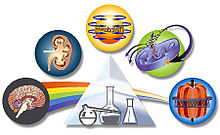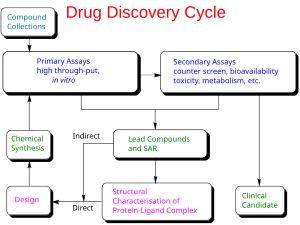Divisions

The discipline of pharmacology can be divided into many sub disciplines each with a specific focus.
Systems of the bodyedit
Pharmacology can also focus on specific systems comprising the body. Divisions related to bodily systems study the effects of drugs in different systems of the body. These include neuropharmacology, in the central and peripheral nervous systems; immunopharmacology in the immune system. Other divisions include cardiovascular, renal and endocrine pharmacology. Psychopharmacology is the study of the use of drugs that affect the psyche, mind and behavior (e.g. antidepressants) in treating mental disorders (e.g. depression). It incorporates approaches and techniques from neuropharmacology, animal behavior and behavioral neuroscience, and is interested in the behavioral and neurobiological mechanisms of action of psychoactive drugs.citation needed The related field of neuropsychopharmacology focuses on the effects of drugs at the overlap between the nervous system and the psyche.
Pharmacometabolomics, also known as pharmacometabonomics, is a field which stems from metabolomics, the quantification and analysis of metabolites produced by the body. It refers to the direct measurement of metabolites in an individual's bodily fluids, in order to predict or evaluate the metabolism of pharmaceutical compounds, and to better understand the pharmacokinetic profile of a drug. Pharmacometabolomics can be applied to measure metabolite levels following the administration of a drug, in order to monitor the effects of the drug on metabolic pathways. Pharmacomicrobiomics studies the effect of microbiome variations on drug disposition, action, and toxicity. Pharmacomicrobiomics is concerned with the interaction between drugs and the gut microbiome. Pharmacogenomics is the application of genomic technologies to drug discovery and further characterization of drugs related to an organism's entire genome.citation needed For pharmacology regarding individual genes, pharmacogenetics studies how genetic variation gives rise to differing responses to drugs.citation needed Pharmacoepigenetics studies the underlying epigenetic marking patterns that lead to variation in an individual's response to medical treatment.
Clinical practice and drug discoveryedit
Pharmacology can be applied within clinical sciences. Clinical pharmacology is the basic science of pharmacology focusing on the application of pharmacological principles and methods in the medical clinic and towards patient care and outcomes.citation needed An example of this is posology, which is the study of how medicines are dosed.citation needed
Pharmacology is closely related to toxicology. Both pharmacology and toxicology are scientific disciplines that focus on understanding the properties and actions of chemicals. However, pharmacology emphasizes the therapeutic effects of chemicals, usually drugs or compounds that could become drugs, whereas toxicology is the study of chemical's adverse effects and risk assessment.
Pharmacological knowledge is used to advise pharmacotherapy in medicine and pharmacy.
Drug discoveryedit
This section may require cleanup to meet Wikipedia's quality standards. The specific problem is: This section contains excessive detail (July 2019) (Learn how and when to remove this template message) |
Drug discovery is the field of study concerned with creating new drugs. It encompasses the subfields of drug design and development.citation needed Drug discovery starts with drug design, which is the inventive process of finding new drugs. In the most basic sense, this involves the design of molecules that are complementary in shape and charge to a given biomolecular target.citation needed After a lead compound has been identified through drug discovery, drug development involves bringing the drug to the market.citation needed Drug discovery is related to pharmacoeconomics, which is the sub-discipline of health economics that considers the value of drugs Pharmacoeconomics evaluates the cost and benefits of drugs in order to guide optimal healthcare resource allocation.citation needed The techniques used for the discovery, formulation, manufacturing and quality control of drugs discovery is studied by pharmaceutical engineering, a branch of engineering. Safety pharmacology specialises in detecting and investigating potential undesirable effects of drugs.
Development of medication is a vital concern to medicine, but also has strong economical and political implications. To protect the consumer and prevent abuse, many governments regulate the manufacture, sale, and administration of medication. In the United States, the main body that regulates pharmaceuticals is the Food and Drug Administration; they enforce standards set by the United States Pharmacopoeia. In the European Union, the main body that regulates pharmaceuticals is the EMA, and they enforce standards set by the European Pharmacopoeia.
The metabolic stability and the reactivity of a library of candidate drug compounds have to be assessed for drug metabolism and toxicological studies. Many methods have been proposed for quantitative predictions in drug metabolism; one example of a recent computational method is SPORCalc. A slight alteration to the chemical structure of a medicinal compound could alter its medicinal properties, depending on how the alteration relates to the structure of the substrate or receptor site on which it acts: this is called the structural activity relationship (SAR). When a useful activity has been identified, chemists will make many similar compounds called analogues, to try to maximize the desired medicinal effect(s). This can take anywhere from a few years to a decade or more, and is very expensive. One must also determine how safe the medicine is to consume, its stability in the human body and the best form for delivery to the desired organ system, such as tablet or aerosol. After extensive testing, which can take up to six years, the new medicine is ready for marketing and selling.
Because of these long timescales, and because out of every 5000 potential new medicines typically only one will ever reach the open market, this is an expensive way of doing things, often costing over 1 billion dollars. To recoup this outlay pharmaceutical companies may do a number of things:
- Carefully research the demand for their potential new product before spending an outlay of company funds.
- Obtain a patent on the new medicine preventing other companies from producing that medicine for a certain allocation of time.
The inverse benefit law describes the relationship between a drugs therapeutic benefits and its marketing.
When designing drugs, the placebo effect must be considered to assess the drug's true therapeutic value.
Drug development uses techniques from medicinal chemistry to chemically design drugs. This overlaps with the biological approach of finding targets and physiological effects.
Wider contextsedit
Pharmacology can be studied in relation to wider contexts than the physiology of individuals. For example, pharmacoepidemiology concerns the variations of the effects of drugs in or between populations, it is the bridge between clinical pharmacology and epidemiology. Pharmacoenvironmentology or environmental pharmacology is the study of the effects of used pharmaceuticals and personal care products (PPCPs) on the environment after their elimination from the body. Human health and ecology are intimately related so environmental pharmacology studies the environmental effect of drugs and pharmaceuticals and personal care products in the environment.citation needed
Drugs may also have ethnocultural importance, so ethnopharmacology studies the ethnic and cultural aspects of pharmacology.citation needed
Emerging fieldsedit
Photopharmacology is an emerging approach in medicine in which drugs are activated and deactivated with light. The energy of light is used to change for shape and chemical properties of the drug, resulting in different biological activity. This is done to ultimately achieve control when and where drugs are active in a reversible manner, to prevent side effects and pollution of drugs into the environment.

Comments
Post a Comment